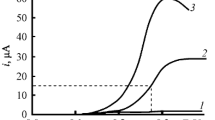Abstract
IN the interpretation of polarographic measurements, it is usually assumed that organic compounds are only reduced when they are adsorbed onto the surface of the mercury electrode1,2. Unfortunately, the term “adsorption” is used for a broad range of interactions between the solid and liquid phase.
Similar content being viewed by others
References
Majranovskii, S. G., Catalytic and Kinetic Waves in Polarography (Nauka, Moscow, 1966) (in Russian).
Tedoradze, C. A., Usp. Electrochim. Org. Soed., 23 (Nauka, Moscow, 1966).
Valenta, P., Chem. Zvesti, 8, 767 (1954).
Breyer, B., and Bauer, H. H., Alternating Current Polarography and Tensammetry (Interscience, New York, 1963).
Vettig, K., Elektrokhimiya, 3, 269 (1967).
Author information
Authors and Affiliations
Rights and permissions
About this article
Cite this article
ZUMAN, P., BARNES, D. Desorption of 3-Phenylpropionaldehyde preceding Polarographic Reduction. Nature 215, 1269–1270 (1967). https://doi.org/10.1038/2151269a0
Received:
Revised:
Issue Date:
DOI: https://doi.org/10.1038/2151269a0
- Springer Nature Limited





